UGC Ads: Mastering Highly Effective Ads at Scale (+Examples)
With over 7 years of e-commerce experience, Agne has mastered the balance of creativity and performance. From guiding social media strategies to crafting high-converting ads, she’s all about results.
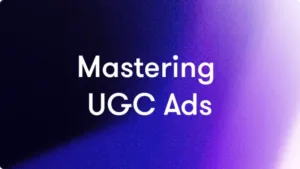
User-generated content (UGC) has become a buzzword that every business and marketer should be familiar with. But what exactly are UGC ads, and why is it so significant in the digital era?
In this blog post, we’ll dive deep into the world of UGC, exploring its definition, its various forms, and the psychology behind why consumers willingly create it.
What is User-Generated Content (UGC)?
User-generated content, or UGC for short, is any content created and shared by unpaid contributors, customers, or fans of a brand, product, or service. This content can take many forms, including text, images, videos, reviews, testimonials, social media posts, and more.
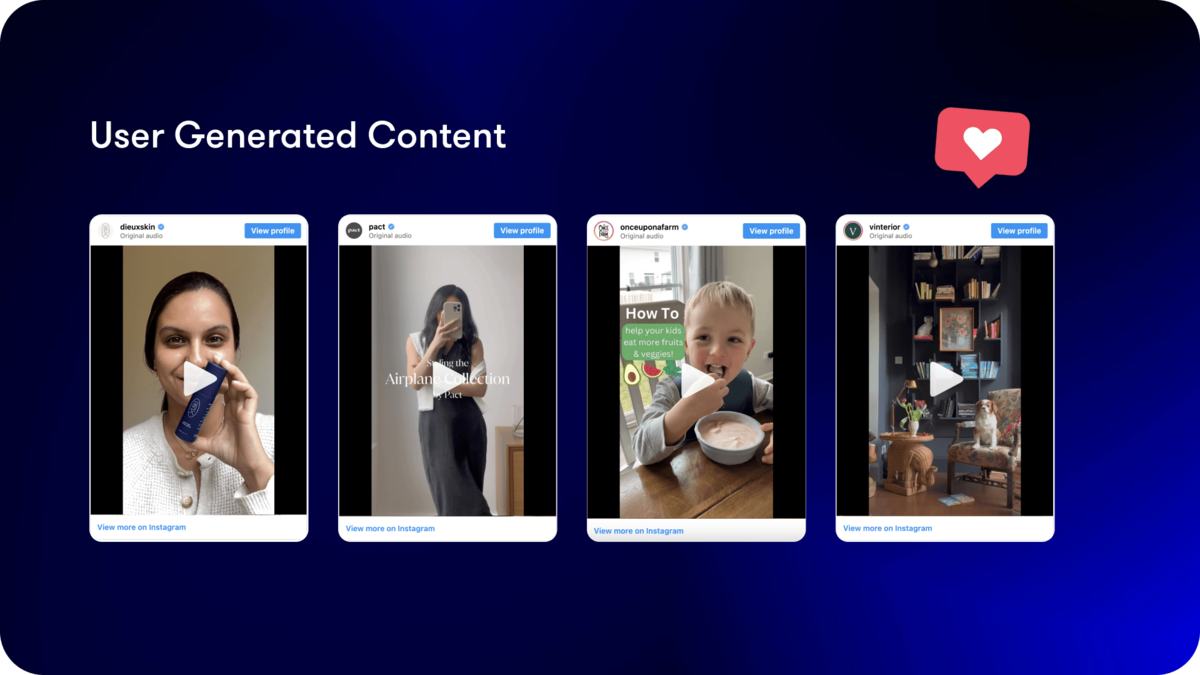
Essentially, UGC ads are the digital word-of-mouth marketing that can have a powerful impact on your brand’s online presence.
Defining UGC and its Significance in the Digital Era
UGC has gained immense significance in the digital era due to the shift in how consumers engage with brands and make purchasing decisions.
In the past, consumers relied heavily on advertisements and official brand messages to make informed choices. However, today’s consumers are more skeptical of traditional advertising and are increasingly turning to UGC for guidance.
Why is this the case? Well, UGC is seen as authentic, unbiased, and relatable.

When potential customers see real people like themselves sharing their experiences with a product or service, it establishes trust and credibility. They can relate to the emotions, opinions, and feedback expressed in UGC, making it a valuable resource in their decision-making process.
Furthermore, UGC is cost-effective for brands. Instead of spending substantial budgets on creating polished marketing materials, brands can tap into the content created by their own customers, saving both time and money.
This grassroots approach to marketing not only reduces costs but also fosters a sense of community around the brand.
Types of UGC Ads: Text, Images, Videos, Reviews, and More
User-Generated Content comes in a wide variety of forms, each offering unique benefits to brands and consumers alike.
Text: This includes blog comments, forum posts, social media comments, and more. Text-based UGC often provides detailed insights and opinions, making it valuable for in-depth product discussions.
Images: Instagram is a goldmine for user-generated images. Customers often share pictures of themselves using products, which can be repurposed by brands for marketing purposes. These images provide visual proof of a product’s quality and appeal.
Videos: YouTube and TikTok are platforms where video UGC thrives. Customers create unboxing videos, tutorials, and reviews that give potential buyers a firsthand look at a product’s features and functionality.
Reviews: User reviews on platforms like Amazon, Yelp, and TripAdvisor have a significant impact on purchasing decisions. Positive reviews can boost sales, while negative reviews can prompt improvements.
Social Media Posts: Consumers share their experiences with products and services on platforms like Twitter, Facebook, and Pinterest. These posts can go viral, reaching a vast audience and increasing brand visibility.
Why Consumers Create UGC: The Psychology Behind It

Understanding why consumers willingly create UGC is essential for businesses looking to harness its power. Several psychological factors drive individuals to share their thoughts and experiences:
- Social Validation: People seek validation from their peers. When their content is liked, shared, or commented on, it validates their opinions and experiences.
- Sense of Belonging: UGC allows consumers to feel like part of a brand’s community. Sharing their experiences reinforces their connection to the brand and like-minded individuals.
- Emotional Expression: Consumers often use UGC as a means to express their emotions, whether it’s excitement, satisfaction, or frustration. Sharing helps them process these feelings.
- Influence and Expertise: Some individuals create UGC to establish themselves as experts in a particular niche or industry, gaining followers and recognition in the process.
User-generated content is more than just a marketing tactic; it’s a powerful tool that leverages the authenticity and influence of your customers to boost your brand’s reputation and credibility.
The Anatomy of High-Quality UGC Ads
When harnessed effectively, UGC can breathe life into your advertising campaigns, providing an authentic and relatable touch that traditional ads often lack. But what distinguishes high-quality UGC ads from mediocre ones?
High-quality UGC ads revolve around authenticity, relevance, engagement, and compelling visual storytelling. These elements are the building blocks of UGC ads that resonate with audiences and leave a lasting impression.
On the flip side, poor UGC ads suffer from a lack of credibility, clutter, and low-quality content.
What Makes High-Quality UGC Ads?
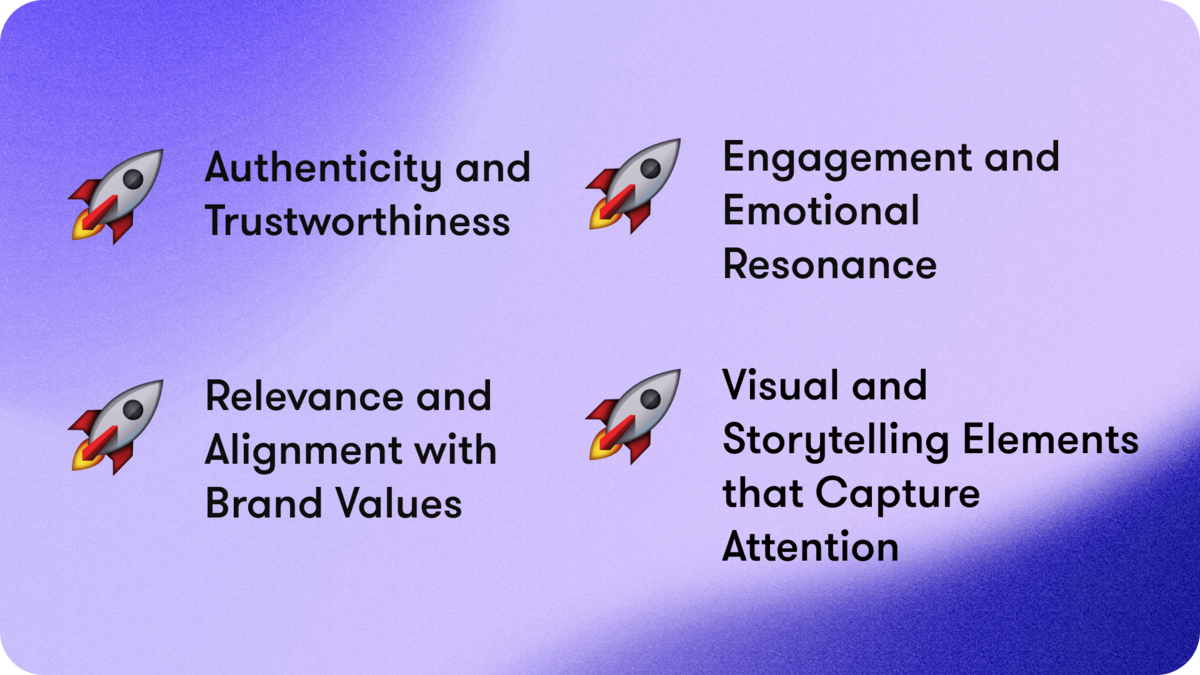
1. Authenticity and Trustworthiness: The Core of UGC Success
At the heart of every successful UGC ad lies authenticity and trustworthiness. Authenticity is the magic ingredient that sets UGC apart from conventional advertisements.
When customers share their experiences honestly, it resonates with others who value real opinions over scripted endorsements. High-quality UGC ads maintain this integrity by showcasing genuine, unfiltered content that consumers can trust.
2. Relevance and Alignment with Brand Values
Effective UGC ads seamlessly integrate with a brand’s values and messaging. When user-generated content aligns with your brand’s identity and mission, it feels more genuine and persuasive.
If your brand champions sustainability, for instance, UGC featuring eco-conscious customers using your products can reinforce your message.
3. Engagement and Emotional Resonance
The best UGC ads not only capture attention but also engage the audience emotionally. They tell a compelling story that strikes a chord with viewers, evoking feelings of happiness, empathy, or inspiration.
By tapping into the emotional aspect, UGC ads become memorable and shareable, amplifying their impact.
4. Visual and Storytelling Elements that Capture Attention
Visuals are the first thing that grabs a viewer’s attention. High-quality UGC ads leverage eye-catching visuals, whether it’s stunning photos or captivating videos. Coupled with a well-crafted narrative, these ads draw viewers in and keep them engaged from start to finish.
Visual storytelling can take viewers on a journey, making them feel connected to the brand and its community.
What Makes Poor UGC Ads?
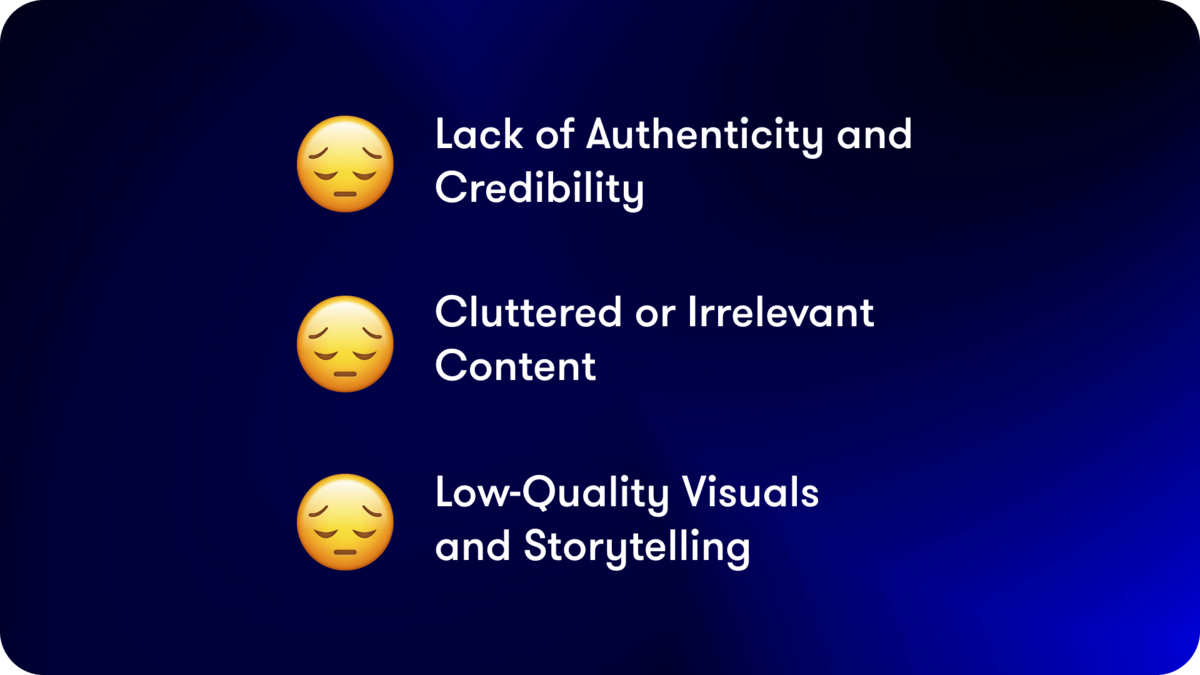
1. Lack of Authenticity and Credibility
The cardinal sin in UGC advertising is sacrificing authenticity. When brands manipulate or fake user-generated content, it erodes trust and tarnishes their reputation.
If consumers sense that a UGC ad is disingenuous or staged, it can have a detrimental impact on brand loyalty.
2. Cluttered or Irrelevant Content
UGC ads that lack focus or coherence can confuse or overwhelm viewers. Irrelevant content, such as unrelated images or off-topic AI captions, can dilute the message and fail to connect with the audience.
Simplicity and relevance are key to ensuring UGC ads hit the mark.
3. Low-Quality Visuals and Storytelling
In the era of high-definition screens and immersive storytelling, subpar visuals and storytelling can be a major turn-off. Blurry images, shaky videos, or uninspiring narratives can quickly push viewers away.
Brands must invest in quality production to make the most of UGC.
Considerations Before Using UGC in Ads
User-Generated Content (UGC) can be a powerful asset for your advertising campaigns, injecting authenticity and relatability into your marketing efforts.
However, before diving headfirst into the world of UGC ads, it’s crucial to consider several important factors to ensure you’re on the right side of the law, ethics, and brand consistency.
Legal and Ethical Considerations of UGC Ads
User Consent and Rights
The first and foremost consideration when using UGC in ads is ensuring you have proper consent from the content creators. Users own the rights to their content, whether it’s text, images, or videos.
Always obtain explicit permission to use their content for promotional purposes. Failure to do so can result in legal consequences.
Compliance with Advertising Standards
Advertisers must adhere to industry and advertising standards when using UGC. Ensure that your ads meet regulatory requirements and ethical guidelines, such as disclosing when content is sponsored or when actors are used to recreate user experiences.
Brand Alignment and Message Consistency of UGC Ads
Ensuring UGC Aligns with Your Brand’s Identity
Not all UGC will align with your brand’s values or messaging. Carefully vet user-generated content to ensure it resonates with your brand’s identity. If it conflicts with your brand’s principles, it may do more harm than good.
Maintaining a Consistent Brand Message
Consistency is key in brand messaging. Ensure that the UGC you choose supports and reinforces your brand’s message rather than diluting or contradicting it. UGC should feel like a natural extension of your brand’s voice.
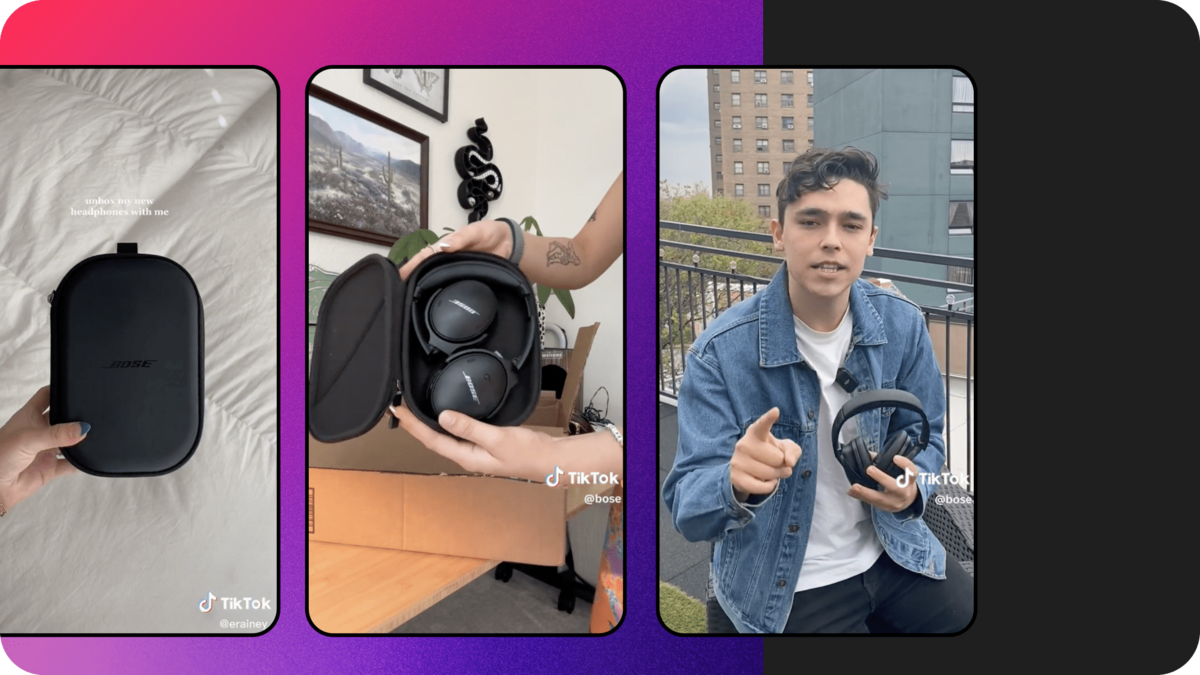
UGC Ad Curation and Moderation
Strategies to Filter and Select the Best UGC
There’s often an abundance of UGC available, so having a curation strategy is vital. Select UGC that best represents your product or service and resonates with your target audience. Consider metrics like engagement, relevance, and alignment with your campaign goals.
Dealing with Negative or Inappropriate Content
Negative or inappropriate UGC is a challenge that every brand may face. It’s essential to have a plan in place to handle such content.
This might involve filtering out negative UGC, addressing concerns with users privately, or setting community guidelines for acceptable content.
Unlocking the Power of UGC Ads: 5 Benefits for Marketers
UGC isn’t just a passing trend; it’s a marketing strategy with tangible benefits that can transform your campaigns.
Benefit 1: Enhanced Authenticity and Trust
In an era dominated by skeptical consumers, trust is the ultimate currency. UGC, born from the real experiences and opinions of your customers, exudes authenticity.
When potential buyers see content created by their peers, it fosters trust. They relate to the genuine emotions, challenges, and triumphs shared in UGC. This trust extends to your brand, making consumers more likely to engage and buy.
Trust in your brand isn’t just built overnight; it’s a continuous effort. UGC contributes to your brand’s credibility by showing that real people have had positive experiences with your products or services.
Over time, this credibility turns into loyalty as satisfied customers become brand advocates, spreading the word about your offerings.
Benefit 2: Cost-Effective Content Generation
Traditional content creation can be expensive and time-consuming.
From hiring photographers and videographers to organizing elaborate shoots, the costs can quickly add up. UGC, on the other hand, offers a treasure trove of content that’s created by your customers for free. It’s like having an army of content creators working on your behalf.
By tapping into UGC, you can significantly reduce your marketing expenses. This cost-effective content generation means you can allocate your budget to other crucial areas, such as strategic advertising or product development.
Benefit 3: Increased Engagement and Conversions
UGC is a magnet for conversions and engagement. User-generated content typically garners more likes, shares, and comments than branded content. Why? Because it resonates with audiences on a personal level.
When customers see relatable UGC, they’re more likely to interact with it and, subsequently, with your brand.
Countless brands have leveraged UGC to boost engagement and conversions. Consider Airbnb’s “Live There” campaign, which featured UGC images and stories from hosts and guests. The result? A 53% increase in website engagement and a 200% surge in bookings.
Benefit 4: Expanding Reach and Social Proof
UGC has the remarkable ability to expand your brand’s reach. When customers share UGC on their social channels, your brand is exposed to their entire network, potentially reaching thousands of new eyes. This organic reach is invaluable.
Social proof is a powerful psychological trigger that UGC harnesses expertly. When potential customers see others enjoying your products or services, it validates their decision to consider your brand.
It’s the online equivalent of a friend’s recommendation, and it can sway purchasing decisions in your favor.
Benefit 5: Data Insights and Customer Feedback
Beyond the marketing benefits, UGC can provide valuable insights into your customers’ behaviors, preferences, and pain points by analyzing UGC’s performance and reception to gain a deeper understanding of your audience, allowing you to tailor your marketing efforts more effectively.
Customer feedback embedded in UGC can serve as a goldmine of information for product or service enhancements. Listening to what your customers are saying and making improvements based on their feedback can lead to greater customer satisfaction and loyalty.
Integrating UGC Into Your Facebook, Instagram, and TikTok Ads
Social media platforms like Facebook, Instagram, and TikTok are fertile ground for UGC to thrive and flourish in. Incorporating UGC into your ad campaigns on these platforms can do wonders for any type of business.

Step 1: Identifying the Right UGC
To get the most out of UGC, you need to start by identifying the right content.
UGC discovery tools like Mention, Brandwatch, and Hootsuite can help you track mentions, hashtags, and user-generated posts related to your brand or products. Social listening tools are invaluable for finding genuine UGC gems.
Beyond tools, engage in active social listening. Monitor your brand’s social media channels, encourage customers to use branded hashtags, and run contests or campaigns that encourage UGC creation.
The goal is to unearth authentic and resonant content created by your audience.
Step 2: Curating and Customizing UGC
Not all UGC is created equal. Curate content that aligns with your campaign goals and brand message. Choose UGC that’s visually appealing, emotionally resonant, and ideally features real customers enjoying your products or services.
Different platforms require different approaches. Tailor your UGC to suit the platform’s style and audience.
For instance, Instagram favors high-quality visuals, while TikTok thrives on creative, bite-sized videos. Customize UGC to fit the context of each platform and specific ad campaigns.
Step 3: Incorporating UGC into Ad Creatives
The visual appeal of your UGC-driven ads is paramount. Ensure that the selected UGC is of high quality and can be integrated seamlessly into your ad design. Maintain a cohesive visual identity that aligns with your brand while letting the UGC shine.
While UGC can tell a story on its own, don’t underestimate the power of ad copy.
Craft copy that complements the UGC providing context, calls to action, and key messaging. The point is to create a harmonious blend of visuals and text that resonates with your audience.
Step 4: Measuring and Optimizing UGC Campaigns
To gauge the success of your UGC-driven ads, track key performance metrics such as engagement rates, click-through rates (CTR), conversion rates, and return on ad spend (ROAS). These metrics can help you understand the impact of UGC on your ad campaigns.
Continuously optimize your UGC campaigns based on performance data.
Experiment with different UGC types, ad formats, and targeting options to find what works best. A/B testing can help you refine your UGC-driven ad strategies over time.
Examples of Brands Effectively Using UGC Ads
1. Airbnb
The “Live There” Campaign: Airbnb leveraged UGC brilliantly with their “Live There” campaign. They featured stunning UGC photos and stories from hosts and guests.
This strategy led to a 53% increase in website engagement and a remarkable 200% surge in bookings. Airbnb effectively showcased real people enjoying unique travel experiences, which resonated deeply with their target audience.
2. GoPro
#GoProAwards: GoPro’s UGC strategy revolves around their #GoProAwards campaign. They encourage users to submit their incredible GoPro-shot videos and images for a chance to win cash rewards.
This campaign not only generates an abundance of captivating content but also engages their community and reinforces their brand’s adventurous spirit.
What We Can Learn from Their Strategies
These success stories teach us valuable lessons:
Authenticity Matters: Airbnb and GoPro both prioritize authenticity. They showcase real people and their genuine experiences, building trust and credibility with their audience.
Engagement is Key: Encouraging user participation, as seen in GoPro’s campaign, can foster a sense of community and loyalty around your brand.
Consistency is Crucial: Both brands maintain a consistent brand message throughout their UGC campaigns, aligning the content with their brand identity.

Other Industries Unique UGC Ad Strategies
UGC isn’t limited to a type of brand or any particular industry:
Food and Beverage: Restaurants and food brands often encourage customers to share their culinary experiences on social media, using hashtags like #FoodieFridays or #TasteOfSummer.
Fashion: Clothing brands like H&M often host UGC contests, asking customers to share their best outfit combinations.
Travel and Hospitality: Hotels and airlines utilize UGC to showcase stunning travel destinations and experiences, much like Airbnb.
Tech and Electronics: Companies like Apple encourage users to share their creative work and experiences using their products, fostering a vibrant community.
How to Get Started with UGC using Billo
Obviously, UGC ads have emerged as a force to be reckoned with. But managing and integrating UGC into your marketing strategy can be a time-consuming task. Enter Billo, your trusted UGC companion.
Billo in a Nutshell
Billo is an all-in-one UGC ordering and management platform designed to streamline the entire UGC journey for brands and marketers. It simplifies the process of discovering, curating, and integrating UGC into your marketing campaigns.
With Billo, you can harness the authenticity and power of UGC without the headaches of manual management.
Check out some of our UGC video examples and creators here.
Frequently Asked Questions (FAQ)
Is it legal to use user-generated content (UGC) in my advertising campaigns without obtaining explicit permission from the content creators?
Using UGC in advertising campaigns typically requires obtaining proper consent from the content creators. Failure to do so can have legal consequences. Always ensure you have the necessary rights and permissions before using UGC in ads.
How can I encourage customers to create more UGC for my brand or products?
Encouraging customers to create UGC can involve various strategies, such as running contests, offering incentives, using branded hashtags, or actively engaging with your audience on social media. The goal is to foster a community of engaged customers who willingly share their experiences.
What steps can I take to moderate or filter out negative or inappropriate UGC before using it in my ads?
Dealing with negative or inappropriate UGC is essential. Brands should have a plan in place to filter out such content, address concerns privately, or establish community guidelines for acceptable content. Having a moderation strategy helps maintain the quality and appropriateness of UGC used in ads.
How can I measure the effectiveness of UGC in my advertising campaigns?
Measuring the impact of UGC in advertising can involve tracking key performance metrics like engagement rates, click-through rates (CTR), conversion rates, and return on ad spend (ROAS). Analyzing these metrics allows you to assess how UGC is influencing your ad campaigns and make necessary optimizations.
Are there any industry or advertising standards that I should be aware of when incorporating UGC into my ads?
Advertisers should be aware of industry-specific and advertising standards when using UGC. This includes complying with regulations and ethical guidelines related to sponsored content, disclosure of paid partnerships, and ensuring that UGC aligns with advertising standards specific to your industry or region.
Creative Manager
With over 7 years of e-commerce experience, Agne has mastered the balance of creativity and performance. From guiding social media strategies to crafting high-converting ads, she’s all about results.

Authentic creator videos, powered by real performance data
22,000+ brands use Billo to turn UGC into high-ROAS video ads.
From Avatars to Authenticity: Navigating the 2025 Wave of AI Generated UGC
That UGC ad you just watched? The person might not [...]...
Read full articleMastering UGC Scripts: Best Practices, Templates & Creator Insight
In 2025, brands are facing the most competitive short-form video [...]...
Read full articleFrom Hashtags to Sales: UGC Campaign Examples That Worked
User-generated content (UGC) campaigns are reshaping how brands build trust and [...]...
Read full article



